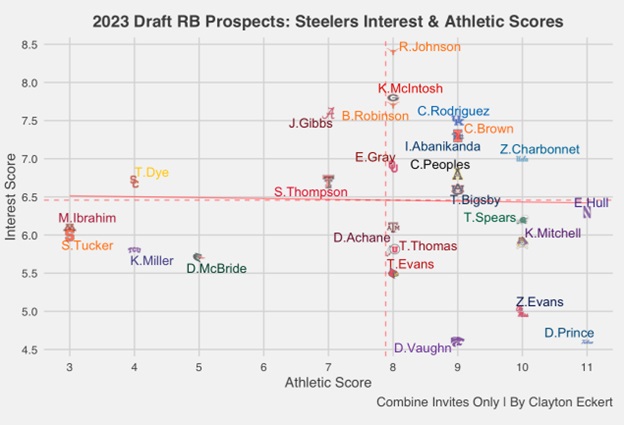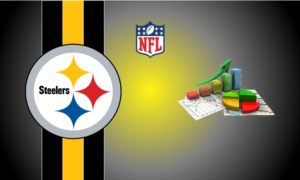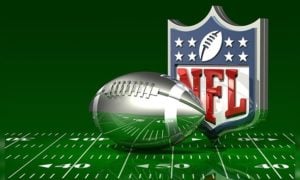For a few of years now, I have kept a running spreadsheet during the draft process. The goal for me is to learn about the players, gathering information that I have tweaked along the way as I’m sure I will continue to do in the future. With great questions and conversations with some your responses to previous articles, people have seemed interested in this information I’ve referenced, so today I will share visualizations of the data points I create each year, simply called interest and athletic scores with explanations to follow.
As Dave Bryan and Alex Kozora discuss regularly, the Steelers have a type of player they look for, and what the scores attempt to achieve is seeing who checks many of those boxes, or vice versa. You will notice many of the inspirations for these scores come from Dave and Alex’s studies of draft trends over the years for Pittsburgh, with their in-depth research second to none. That is one of the main reasons I pursued a position and count my blessings to work with the great football minds at Steelers Depot. While there is no perfect way to predict what selections the Steelers will make in the draft at the end of the month, I feel great about what the data points measure and of course would love to hear feedback as I’m always looking to improve the points system. Also, there is only so much time in the day and additional things I’d like to measure, so I focus on the crucial and/or practical choices in my opinion.
Now for more explanation to how the scores come together. The biggest point I want to make is that this is not a big board or round projection view, rather trying to pinpoint names the Steelers may select regardless of when they are drafted. After I get a healthy pool of names that I hear about or research, I begin the scoring.
Interest Score: Here I configured a points system for the following important questions. How did the players perform in college? Does their height and weight match up to the body type of any player Pittsburgh has drafted at the position the last 10 years? What is their experience/age? Do they play a position of need? What was their level of competition? Who attended their pro day? Did they have meeting(s) with the Steelers pre-draft? Did they appear in the Senior, Shrine, or NFLPA Bowl?
This matches up nicely to the Athletic Score: simply 11 combine metrics excluding wingspan, and whether or not they were within a threshold in each metric of any player drafted at their position by the Steelers since 2013.
Clear as mud? Here are the running backs who were Combine invites:
NOTE: If you don’t see a name please ask, I have many more non-combine players compiled but excluded them for a cleaner chart.
Right away we get a sense of less need at the position, with Roschon Johnson of Texas topping the interest scores at just 8.4, with an informal combine meeting, scout Merril Hoge at his Pro Day, an eight athletic score (three DNPs). He is projected to be a late day-two/early day-three pick, a great fit but likely too rich an investment for Pittsburgh.
Seven prospects land in the seven range, starting with Georgia’s Kenny McIntosh (7.8). He had strong Pro day attendance (perhaps less notable with the Bulldogs’ slew of prospects and lack of Steelers’ offensive coaches), an eight athletic score (DNP on the bench with lower 4.69 shuttle and 7.69 three-cone times than Pittsburgh has drafted the last decade). He is seemingly a day-three prospect. Bijan Robinson of Texas (7.7) also had Hoge at his Pro Day, an eight athletic score (three DNP’s) but no pre-draft meeting. He will likely come off the board in the first round, well before Pittsburgh should consider the position. Alabama’s Jahmyr Gibbs (7.6) had strong Pro Day attendance (less notable for season reason as with Georgia Pro Day), a seven athletic score (four DNP’s), lacked pre-draft meetings, and seems to be a day-two pick. Kentucky’s Chris Rodriguez Jr. (7.5) had an informal Combine meeting, less Pro Day attendance comparatively, a nine athletic score (two DNPs and 8 5/8” hands missing the mark). He is seemingly a day three player. Chase Brown of Illinois (7.3) also had an informal Combine meeting, a nine athletic score (two DNP’s), less Pro Day attendance, and appears to be a day-three prospect. Israel Abanikanda (7.3) of Pittsburgh, which was the only school running backs coach Eddie Faulkner appeared at, lacked a pre-draft meeting and has a nine athletic score (DNP on the bench and 8 1/4” hands missing the mark). He is another running back projected to go on day three. UCLA’s Zach Charbonnet (seven interest score) did not have a meeting and less Pro Day attendance than previous names and a 10 athletic score (low 4.46 shuttle). He seems to be a solid day-two selection.
Here are some other Combine invites who met informally with Pittsburgh there: Appalachian State’s Camerun Peoples (6.8 interest score, nine athletic score), USC’s Travis Dye (6.7 interest score, four athletic score), Auburn’s Tank Bigsby (6.6 interest score, nine athletic score), East Carolina’s Keaton Mitchell (5.9 interest score, 10 athletic score), and Kansas State’s Deuce Vaughn (4.6 interest score, nine athletic score). Two Combine players yet to be mentioned had perfect 11 athletic scores: Northwestern’s Evan Hull (6.3 interest score) and Tulsa’s Deneric Prince (4.6 interest score). A non-Combine invite who garnered the strongest interest score was Arizona State’s Xazavian Valladay (6.1). Harvard’s Aidan Borguet also received pre-draft interest from Pittsburgh. North Dakota State’s Hunter Luepke may end up being a fullback, but really jumps out as a versatile piece that I’d enjoy, and likely will be available late in the draft. Considering the obvious lack of interest in the process and many other needs, it seems Pittsburgh may not draft the position. If it does, I’m hoping it’s a late-round pick or more preferably waiting to see what’s available in the undrafted pool.
Do you think Pittsburgh will draft one of the players listed above? Who are some of your favorites? Thanks for reading and let me know your thoughts in the comments.









